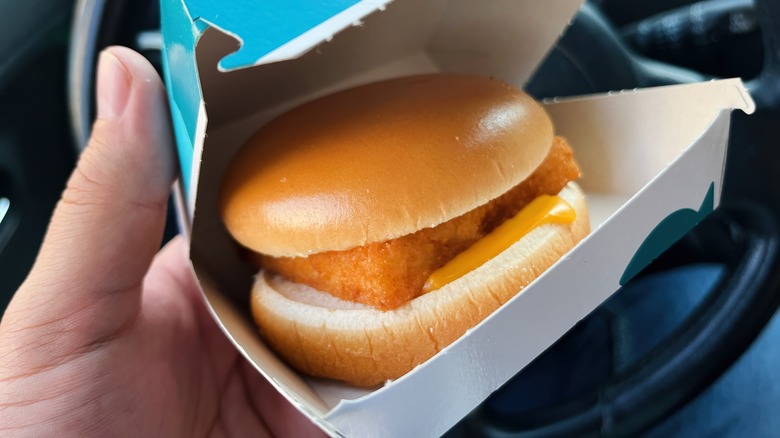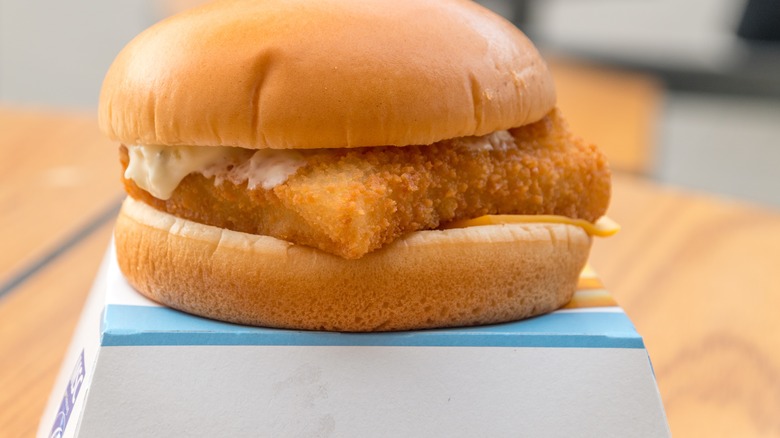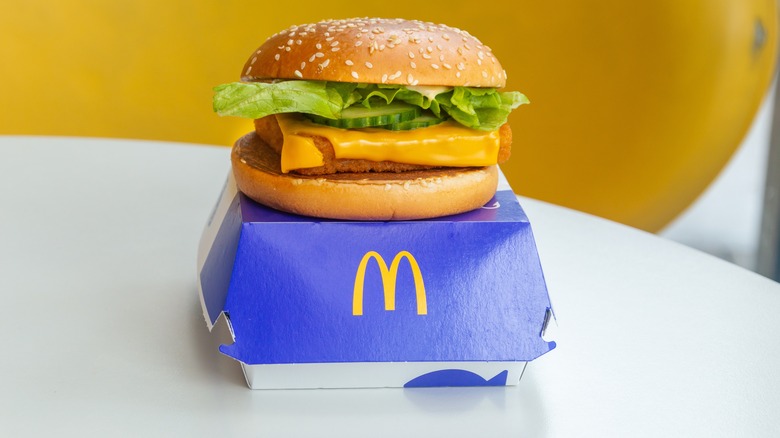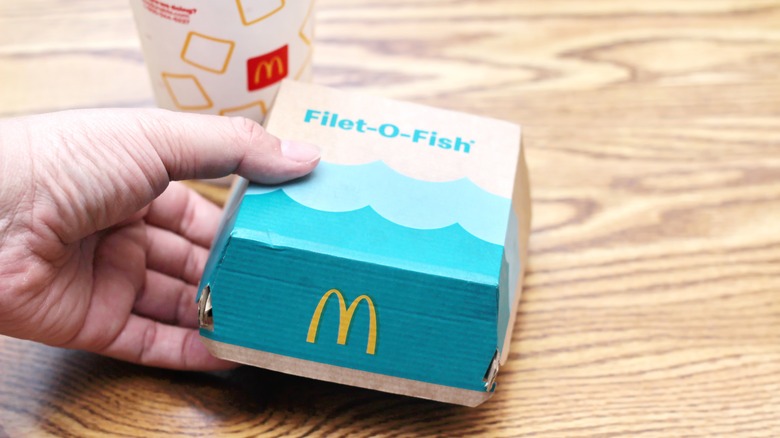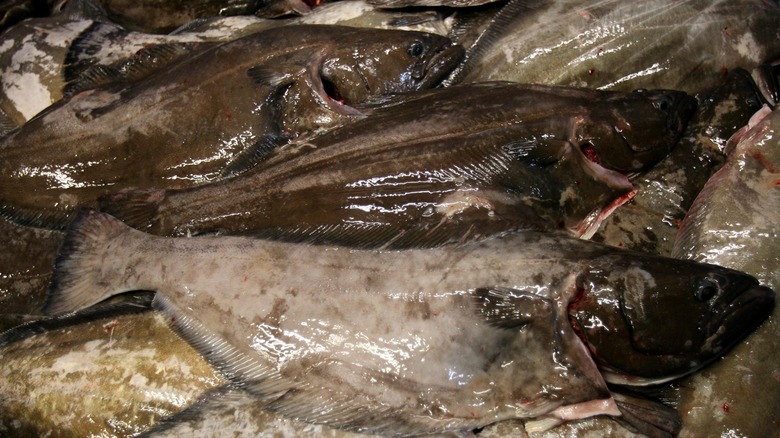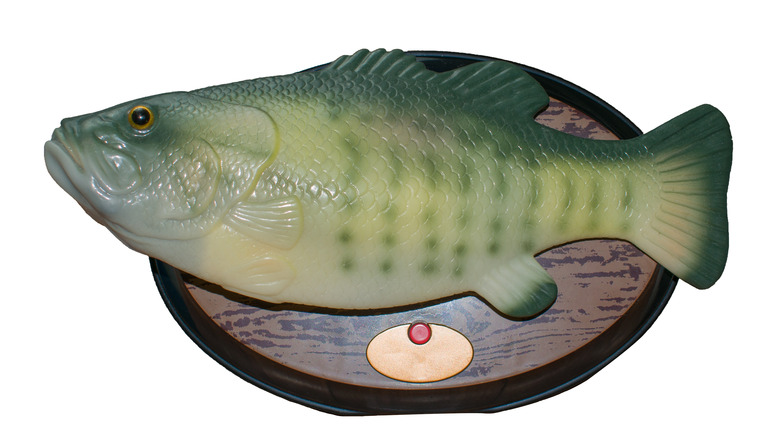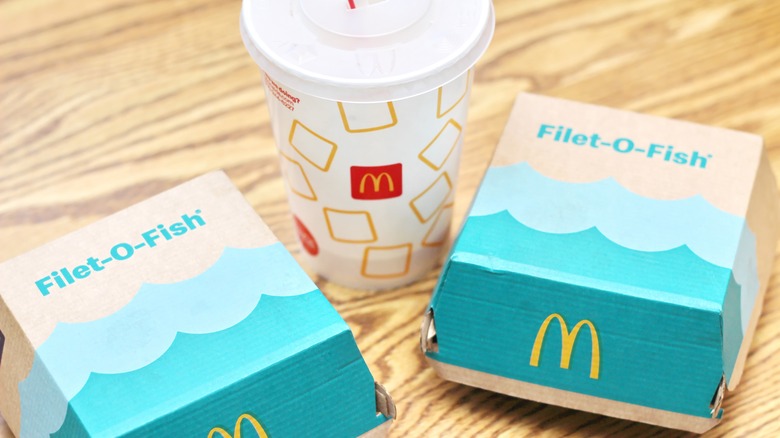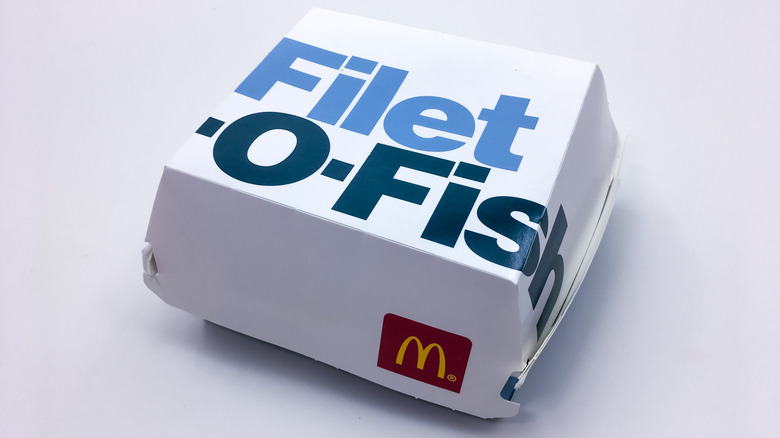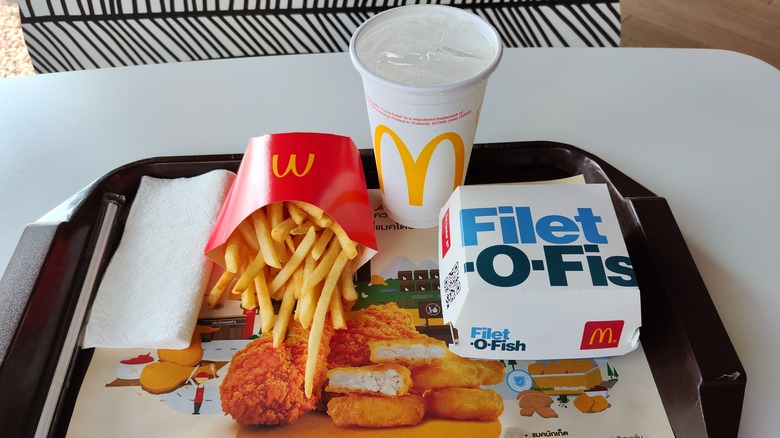The Story Behind McDonald's Filet-O-Fish
For hungry eaters around the world, the name McDonald's brings to mind the classic trifecta of burgers, fries, and shakes. But these treats, popular as they are, aren't the only reason diners flock to the Golden Arches. A quiet, but sizable minority frequent McDonald's to indulge in an old and often overlooked favorite: The Filet-O-Fish sandwich.
Compared to the Big Mac with its multiple layers of bread and meat and colorful array of condiments, the Filet-O-Fish is a demure — and some would say boring — little thing: Just a soft, squishy bun (which doesn't even have sesame seeds), a smear of tartar sauce, and a rectangle of fried white fish topped with half a slice of melted American cheese. It's a plain-looking combination of soft foods in various shades of yellow. But its charms are real: Children find its gentle flavors and textures appealing, as do diners who prefer not to eat beef. And for a sandwich with such an unassuming appearance, it has a fascinating history.
Catholic doctrine inspired the invention of the Filet-O-Fish
When Lou Groen opened his McDonald's franchise in Monfort Heights, Ohio, in 1959, he realized within a few weeks he had a serious problem: He'd inadvertently situated his restaurant in a predominantly Catholic neighborhood — and during this time, observant Catholics refrained from eating meat on Fridays and during Lent, the 40-day period leading up to Easter. Because the only sandwiches McDonald's offered at the time were burgers, this meant that for more than two months out of every year, his restaurant was pretty much out of commission.
Groen noticed, however, that a nearby restaurant was doing booming business on Fridays (and during Lent) thanks to a fish sandwich on its menu. To keep his own restaurant afloat, Groen decided to develop his own fish sandwich. He played around with different recipes, aiming to develop a formula that was both cost-effective for him and appealing to diners. He settled on a sandwich that featured a battered halibut filet topped with a slice of cheese — and the first prototype for the Filet-O-Fish was born. Just as he'd hoped, his sandwich became a hit — and soon Fridays at his restaurants became as busy and profitable as Saturdays.
McDonald's CEO Ray Kroc hated the idea of the Filet-O-Fish
As a McDonald's franchisee, Filet-O-Fish inventor Lou Groen needed approval from the head office to make any major changes, such as adding new menu items. In the late 1950s and early '60s, individual operators could still contact McDonald's CEO Ray Kroc directly to share their ideas and concerns. And Groen didn't hesitate to do so. Thus, when he came upon his idea of offering a fish sandwich, he went to McDonald's headquarters multiple times to sell the idea to Kroc.
This was an uphill battle for Groen, as Kroc hated the idea from the start. "You're always coming up here with a bunch of crap!" Kroc told Groen. "I don't want my stores stunk up with the smell of fish." Eventually, however, Groen convinced Kroc to give the Filet-O-Fish a chance — and the sandwich's steady popularity proved a boon for both Groen and McDonald's. Groen would grow his McDonald's business to include 43 franchises, and the Filet-O-Fish would later appear on menus in more than 100 countries.
A pineapple sandwich nearly beat out the Filet-O-Fish as the meatless sandwich option
Another possible reason McDonald's CEO Ray Kroc initially opposed the idea of the Filet-O-Fish — besides the prospect of fried fish smells in his restaurants — was that he had his own idea for a meatless sandwich up his sleeve. He envisioned instead the Hula Burger, a ring of grilled pineapple topped with cheese and served on a bun.
Kroc was confident enough in his idea to offer Filet-O-Fish inventor Lou Groen a deal: They'd offer both sandwiches at a few McDonald's locations, and the sandwich with the most sales would earn a permanent spot on the menu. The grand experiment launched on Good Friday 1962, and the results were clear: Customers ordered 350 Filet-O-Fish sandwiches — and only six Hula Burgers. According to the Smithsonian: "It [the Hula Burger] was a giant flop when we tried it out in our stores," Kroc later conceded in his memoir. "One customer said, 'I like the hula, but where's the burger?'"
McDonald's offers variations of the Filet-O-Fish internationally
If you've ever been homesick while traveling abroad and peeked into a McDonald's, you almost certainly saw more reminders you're not home. Besides signage in the local language and currency, you'll likely see menu items unlike any you'll find at home. The restaurant's branding will look familiar, but the menu will reflect local tastes. (If you want to try some of these Stateside, visit McDonald's Global Menu Restaurant at the company's headquarters in Chicago.)
Even familiar items such as burgers and sandwiches get different treatments in different markets. For instance, while the Filet-O-Fish is offered at McDonald's restaurants around the world, it can take forms that may raise the eyebrows of American diners. Singapore, for instance, offered a limited time Double Wasabi Filet-O-Fish, a sandwich with two stacked fish fillets, cheese, and a special wasabi sauce. McDonald's France offers a different take on a wasabi Filet-O-Fish, which comes with a single fish fillet topped with a not-too-spicy wasabi sauce along with crispy onions and melted cheddar. And in the United States diners in a few select restaurants can enjoy the sandwich with a special Old Bay-seasoned tartar sauce.
Almost a quarter of Filet-O-Fish sales happen during Lent
One reason the Filet-O-Fish was a success when it was launched was it served a captive audience: Devout Catholics, who weren't allowed to eat meat on Fridays or during Lent. But soon after its nationwide launch in 1965, McDonald's CEO Ray Kroc told some of his staffers, "You fellows just watch. Now that we've invested in all this equipment to handle fish, the Pope will change the rules."
Kroc's joke proved prescient. That year, the Second Vatican Council concluded and enacted a radical modernization of church practices. Among these was the end of the restrictions against eating meat on Fridays, but not during Lent. The Filet-O-Fish continues to be a Lenten staple, and today, almost a quarter of all Filet-O-Fish sandwiches are sold during Lent.
A 2024 promotion offered Filet-O-Fish sandwiches for just $1
While the Filet-O-Fish is available year-round at McDonald's and attracts a steady stream of devotees, the Lenten season continues to be Filet-O-Fish season, and store operators know to expect a rush of orders for this normally under-the-radar classic.
It's unclear whether modern diners flock to the Filet-O-Fish during Lent out of habit or nostalgia, but McDonald's corporate leadership is more than happy to encourage their habit. To draw even more attention to the seasonally popular sandwich, in 2024, McDonald's launched an offer no fish lover could refuse: During Lent, diners who purchased a Filet-O-Fish at participating outlets could get a second sandwich for just $1. This was welcome news for fans of the sandwich with hearty appetites as well as parents seeking an affordable but tasty lunch for their kids.
The type of fish used in the Filet-O-Fish changed over time
You might be pleasantly surprised to learn that the piece of fish in your Filet-O-Fish is indeed an actual fish filet, rather than the processed minced fish blend used to make fish sticks. For the Filet-O-Fish, McDonald's uses wild-caught Alaska pollock, flash-frozen on the boat, which is cut into rectangular filets, breaded, and par-cooked before it's frozen and shipped off to individual restaurants. Not only is it real fish, it's sustainably harvested. In 2013, the fish in Filet-O-Fish earned a sustainable rating from the Marine Stewardship Council.
However, this is just the latest iteration of the Filet-O-Fish formula. While the basic form of the sandwich has remained comfortably consistent over the years, the type of fish used in the filets has changed multiple times. For the first prototypes of the Filet-O-Fish, inventor Lou Groen used halibut filets. Once McDonald's agreed to add the Filet-O-Fish to its menu and scaled up Groen's recipe, the chain switched from halibut to cod. Later, it used New Zealand hoki fish, a variety that had become so popular with fast food purveyors that its stocks rapidly diminished. By 2013, in the interest of preserving a steady, sustainable supply of fish, the chain switched to Alaska pollock.
A singing bass in a Filet-O-Fish promo was so popular McDonald's sold it
Besides its burgers and fries, McDonald's is famed for its memorable brand mascots, from Ronald McDonald to the Hamburglar. In 1976, McDonald's introduced a cartoon spokesman for the Filet-O-Fish, appropriately named Phil A. O'Fish. Phil proved short-lived, however, and disappeared from McDonald's ads by 1977. After that, ads for the sandwich were mascot free and focused on the virtues of the sandwich itself.
This changed, however, in 2009, when McDonald's launched an ad for the sandwich that went viral. It featured a plastic trophy fish on a wall plaque — a close copycat of the Big Mouth Billy Bass novelty toy — singing "Give me back that Filet-O-Fish" as two men sitting nearby stare at it while silently eating their sandwiches. (The advertising team charged with the campaign worked out of a meeting room nicknamed The Fishbowl, which inspired a conversation about fish-themed toys, which in turn led to the offbeat ad concept.) The strange, catchy ad inspired ring tones and drew more than 1 million YouTube viewers, and proved so popular McDonald's started to sell the singing fish itself. Today, collectors can still find these novelty fish for sale online.
The Filet-O-Fish is especially popular with Asian-American diners
While devout Catholics were the initial intended audience for the Filet-O-Fish, they aren't the only group with a special fondness for the sandwich. Asian-Americans, especially Chinese-Americans and Muslims, have also become Filet-O-Fish loyalists. For Chinese-Americans (especially those with roots in south China, where seafood is an everyday staple), the fishy flavor is comforting and familiar, as is the softness and sweetness of the steamed bun, evocative of a steamed bao.
Muslim Americans, like pre-Vatican II Catholics, have also embraced the Filet-O-Fish for religious reasons: Muslims can only eat meat, such as beef and chicken, from animals that have been slaughtered according to Islamic principles, which rules out fast-food burgers and chicken sandwiches. No such strictures apply to fish, however, and this has made the Filet-O-Fish the menu item of choice for observant Muslim diners. The fact that the Filet-O-Fish appeals both to kids and adults, as well as to those for whom burgers are not an option or a cultural preference, makes it perhaps the most democratic of McDonald's sandwich offerings.
The Filet-O-Fish isn't McDonald's only seafood offering
McDonald's founding CEO Ray Kroc initially hated the idea of the Filet-O-Fish because he disliked the potential fishy smells in his restaurants. Even today, more than 60 years after the Filet-O-Fish was introduced, it still feels like an outlier on the menu. While McDonald's has expanded its menu over the years to include chicken sandwiches and breakfast dishes, the Filet-O-Fish still remains the only seafood most of us have ever seen on offer.
Dig deeply enough, however, and you'll find a few other seafood options at McDonald's. These options aren't available everywhere, nor are they available year round. McDonald's customers in Japan, for instance, can enjoy an Ebi Filet-O, a sandwich featuring a fried patty of shrimp chunks with lettuce, mustard, and a sweet and tangy sauce. Visit select McDonald's outlets in New England during the summer tourist season and you can get the restaurant's version of a traditional lobster roll – thawed frozen lobster tossed with mayonnaise served on a bed of lettuce in a toasted bun.
Has the Filet-O-Fish gotten smaller?
The Filet-O-Fish has always been a modestly sized sandwich. But in recent years, numerous online critics and fast-food fans have grumbled that the already small sandwich seems to be shrinking further — yet another example, they claim, of the nefarious trend of shrinkflation, in which corporations reduce the size of familiar products in the name of profits. To add insult to injury, critics have noted that the sandwiches not only appear smaller, but are unmistakably more expensive. Some specifically noted that the sandwich now sports just half a slice of American cheese, rather than a whole slice.
McDonald's however, denies these claims. "The size and build of the Filet-O-Fish, including a half slice of American cheese, has not changed in decades," a McDonald's representative told Business Insider. Indeed, according to McDonald's, the choice to top the sandwich with just half a slice of cheese was intentional – more cheese would overwhelm the delicate taste of the fish. And former McDonald's corporate chef Mike Haracz, who regularly posts McDonald's-related tips and secrets, confirms that the Filet-O-Fish seems to be the same size it's always been. According to the New York Post, Haracz said on TikTok, "I don't think it's any smaller than it has been for a while — [but] it's very expensive."

